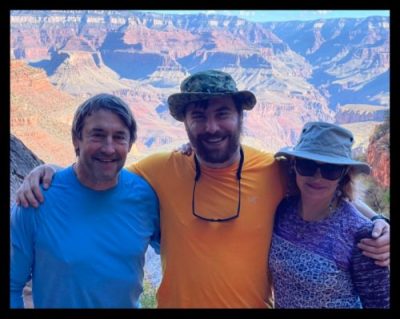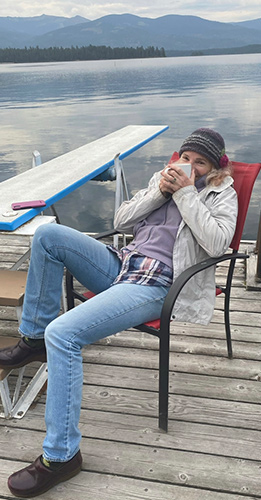I am still basking in the afterglow of last month’s Grand Canyon adventure. Early in the pandemic, I came across an article on backpacking in Grand Canyon in one of the travel magazines my husband, Nick O’Connell, occasionally writes for. This article planted a little seed, or maybe a wild hair, in my head to do a 4 day/3-night backpacking trip down into the depths of Grand Canyon and then back out. Although I am an avid day hiker, I had not backpacked since college so this was a stretch for me at the ripe age of 65. Floating this idea to my family, I soon had two enthusiastic partners in this adventure, my husband and one of our sons, Daniel.

Me with my husband and son soon after our arrival on the South Rim of Grand Canyon.
Although my husband is an experienced outdoorsman, I pushed to use a guide mainly to get a permit (not an easy thing), arrange transportation from Flagstaff (another not so easy thing), plan the food (no thanks) and hopefully maintain marital and familial harmony (it did). We went with Wildland Trekking out of Flagstaff.
Within days of making a deposit the emails started arriving about preparing for this adventure. There was no sugar coating. Training for this was essential if the experienced was to be enjoyed rather than just endured. About 4 months before our trip, right after I retired, I started training in earnest. This involved a lot of walking up and down the hills of Seattle with a pack that started at about 5 pounds and increased to 30 pounds as I got stronger. (My training was curtailed for a few weeks following a harrowing car accident – not my fault! – which left my beloved stick shift purple Mini Cooper totaled and me bruised and sore from the airbag and seat belt. That’s another blog. Stay tuned.) Nick and I also did at least one hike a week in the Cascade mountains near Seattle with full packs. I also upped my weight training and yoga, drank protein supplements and slimmed down about 5 pounds.
We arrived at the North Rim and being a sea level dweller, I felt the altitude – 8,297 feet. Once I donned my 30-pound pack, I really felt the altitude. Carrying a pack uses all kinds of muscles that, at least with my day-to-day activities, don’t get used much. I was very, very grateful for all those hours and miles of schlepping that increasingly heavy pack all over Seattle and the Cascades. Our awesome guide, Karla Kennedy had many stories of clients and their mistaken belief that distance running, swimming, Cross Fit, weight training, Zumba, etc. would be enough. As the early emails from the guiding company had stated, the best training for schlepping a pack is schlepping a pack. So that was lesson number one. Train! Train right!
Karla, a 40 something biologist by training and experienced Grand Canyon guide, had an amazing depth and breadth of knowledge about back country trekking, botany, geology, and history relating not just to our endeavor at hand but life in the outdoors in general. Her hard skills were surpassed only by her soft skills. Within minutes of our departure from the North Rim, she established a hierarchy within our group. My husband, who is the nicest guy on the planet, likes to be in charge on the trail. After all, he’s summited Mt. Rainier many times, summited Denali once, has trekked in the Himalayas, has ice climbed in B.C., backcountry skied all over the United States and Europe and lived to write about it. He knows what he’s doing. But……………..Karla, without Nick even noticing, assumed the alpha role with authority laced with good cheer. So that was lesson number two. Someone needs to be in charge and hierarchy, which has gotten a bad rap in the Woke World, serves an important purpose in serious endeavors.
Fortunately for my oxygen needs, but unfortunately for my quads, the first day was a steep downhill 8 miles to a breathable altitude of 4049 feet. We soon got into a rhythm and I was very grateful for the pacing imposed on our group by our wonderful guide. Normally, when I hike with Nick, it’s a grueling blast to the top of the peak. Just get there. That usual M.O. would not have worked on this trip. Just when I was feeling really, really fatigued and cranky, Karla would read my mind (I never once complained, really) and we would take a break. Off with the packs. Another sip of water and then a hearty snack. We had oodles of snacks, Karla’s orders. My favorites were Cliff Bars with Megan Rapino or Venus Williams, two of my favorite badasses, on the wrappers. Enjoy the view, enjoy the moment, regroup, eat up, feel that blood glucose level inching up and hey, look at these fossilized lizard foot prints on this rock. They are one bajillion years old. Then back with the pack and onto the trail. This was our routine for the 4 days of the trip. Lesson number three. It’s okay to rest and snack!
And now that I’m back home and working on my memoir (working title is The Human Condition: Sometimes It Isn’t Pretty), I think about my long career in surgery and how these lessons did or did not apply. The first one certainly did. There is no way to learn to be a surgeon except to operate. You start slow and small and with a lot of supervision. You build on your skills and learn new ones. There is no substitute for putting in the time and getting those case numbers. Attention medical students looking at surgery residencies: Go for the programs with high volumes. All the academic yada, yada, yada in the world will not make up for time not spent in the operating room.
The second lesson of hierarchy has been under attack in medicine for most of my career. (And do not confuse hierarchy with assholery. There is no place for assholes in medicine.) While it is important for all members of a surgical team to be heard and respected, the surgeon remains, as he or she must, the captain of the ship. Any misadventure in the operating room, regardless of the cause of such misadventure, becomes the surgeon’s problem. The forgotten epinephrine in the liposuction tumescence solution? Umm. The nurse forgot but it’s the surgeon who must deal with the bleeding and explain to the patient why the case was not completed as planned. The pregnant nurse tripping over the IV pole and sending it crashing onto an asleep patient’s face? Umm. It’s the surgeon who assures the patient and his family that nothing was broken and those bruises should fade in a couple of weeks. That piece of belly button fuzz (ewwwww) missed during the surgical prep? Umm. That postoperative wound infection will be the surgeon’s problem. Thus, the person with the responsibility, the surgeon in the OR and Karla on the trail, must be the person with authority.
The third lesson? Rest and snacks. Geeze, I wish I had embraced that concept during my career. It’s not unusual for a surgeon to operate 4, 6, or even 8 hours without taking break. It’s truly crazy to work that way considering that a quick break to stretch, down a Megan Rapino or Venus Williams Cliff Bar and a glass of water and a quick trip to the ladies (or gentleman’s) room would only take, really, about 6 minutes assuming there are no fossilized lizard tracks to contemplate. Then, back the surgeon could come to the OR, refreshed and strong. I’m convinced it would actually speed up the completion of a case. Typically in a long case, the nurses, techs and anesthesiologist get spelled but not the surgeon. So why, why, why? It’s a culture thing mostly. And honestly, it took this backpacking adventure to even put the idea of planned breaks in my head. If you are a surgeon, young or old or in between, consider taking a break during those long cases. It won’t make you less badassy than you already are. Just tell the staff that it’s Karla’s orders.
Thanks for reading! Dr. Lisa Lynn Sowder (blissfully retired)
I’d be honored if you followed me on Instagram @lisalynnsowder, @sowdermd and @breastimplantsanity.



 @lisalynnsowder
@lisalynnsowder
